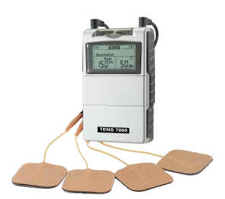When anyone chooses to seek out a Physiotherapist, be it for post operative rehabilitation, a sport injury, neurological symptoms or even post natal (the list goes on!)
The bottom line is that they are attending the clinic because they are in pain. While there is much importance on the diagnosis of the source of the pain, the Physio will want to relieve it within the first instance and TNS may well be the first choice for immediate relief.
TNS (also known as TENS) stands for Transcutaneous Electrical Nerve Stimulation. Interferential Diathermy and TNS offer the same pain relief ability.
As we all know pain is a response to an unpleasant physical or emotional stimulus transmitted to the brain to be recognised as anything from mild discomfort to agony. The quality of pain can be determined by the brain such as burns, pinch, stab, dull ache, nerve pain etc. The stimulus of pain is transmitted to the brain by special nerve pathways some of which are slow and others fast depending on the stimulus. While any pain is undesirable our ability to feel it acts as a protection mechanism causing us to withdraw quickly from the stimulus and protect ourselves from further harm. Emotional pain has a much more complicated pathway but can still be aided with the use of TNS.
When I was training an analogue TNS unit was the size of a small handbag and was initially not available for the patient to take home however (just like mobile phones) they have become digital, more compact and user friendly with governors and pre programmed treatments for safe home use. TNS units are now battery operated and come in a wide range of models to treat not only pain but also to stimulate muscle contraction. It is important to discuss with your Physio before purchasing in order to choose the correct unit for your needs. An obstetric or pelvic floor TNS is unlikely to help sciatic pain or tennis elbow. While this may sound obvious, the range on the market is so wide that it is easy to make a mistake.
How Do They Work ?
As already mentioned, pain is perceived at cerebral level by specialised nerves sending the stimulus from the source of the pain, up the nerve pathways via the spinal cord. The Pain Gate Theory suggests that there is an ability to block out signals by using sensory input to interfere with the transmission of the pain to the brain. This can be explained using sciatica as an example. Sciatic pain is predominantly felt in the leg although the source of the pain is often a vertebral disc pressing on the nerve where it exits the spine. The TNS stimulus can close the gate on the referred pain coming from the sciatic nerve by exciting the ABeta sensory fibres reducing the transmission of the nerve fibres which are carrying the pain and so diminish discomfort which will then reduce muscle tension and aid in recovery.
TNS can also be used in frequencies designed to stimulate ADelta nerve fibres to enable the release of endorphins (opioids) from the spinal cord. Endorphins are like your own personal corticosteroid which is commonly known as an injection to relieve pain. However with the use of TNS you are encouraging the release of your own cortisone and not a manufactured alternative.
Patients´ responses to TNS are varied because everyone has their own pain tolerance threshold. It can take a few treatments to find the correct frequency and pulse width best suited for the individual´s pain relief.
Wireless TNS
This TNS Unit has proved to be most popular within the yachting community.
While it is not as efficient in treating large joints (such as chronic knee pain or hip arthritis) it is versatile for niggling day to day issues such as ligament strains, neck and back pain, tendonitis, bursitis … and is easy to use while “on the go”.
Contraindications and Precautions
- Pacemakers or other implanted electronic devise. Hearing Aids should be removed.
- Skin allergies may be affected by the gel electrodes.
- Reduced skin sensation.
- Use of a TNS should be monitored by a professional if the patient is pregnant and likewise if the patient is a child.
- Should not be used on or around a skin lesion.
















0 Comments